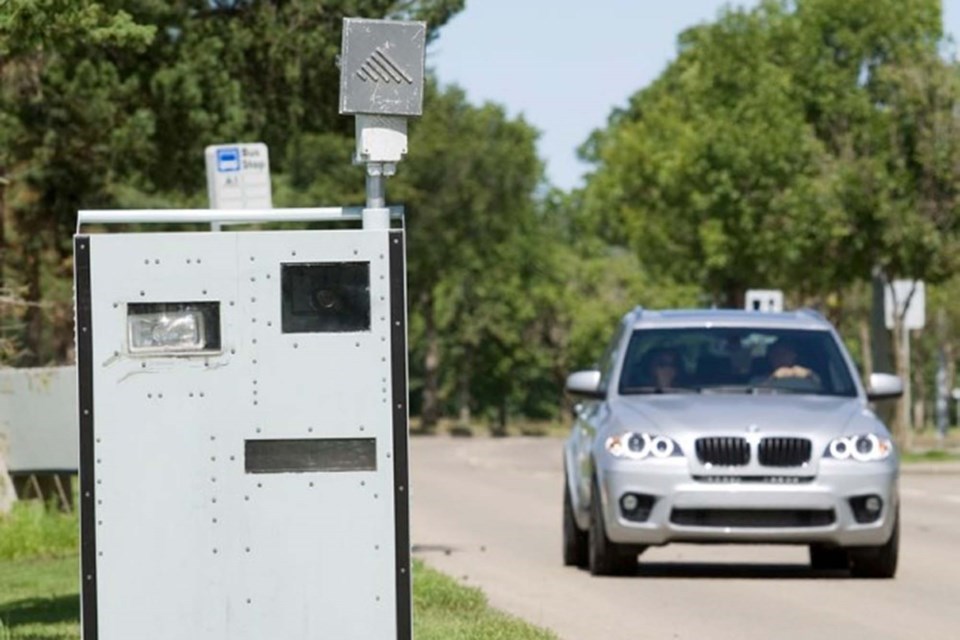The City of St. Albert may need to hire a new full-time staff member to navigate the provincial red tape around photo radar.
On Tuesday, city council's standing committee of the whole heard that even though council decided to maintain the status quo for photo radar or Automated Traffic Enforcement (ATE), it still might require an additional staff member to navigate the rules around the program.
Currently, St. Albert's photo radar program includes three red light cameras in intersections along St. Albert Trail, as well as three mobile enforcement vehicles. Under the current contract, which is set to expire in May, Global Traffic Group provides a little less than 7,000 enforcement hours per year, which averages out to 18 hours per day.
According to city statistics, 21,304 tickets were issued last year totalling $1.6 million in fine revenue, however, after deducting program expenses, the revenue dwindled down to about $740,000.
Although a decision to maintain the status quo means the city won't be increasing or decreasing photo radar efforts, the city may need to hire an additional full-time staff member as early as 2025 in order to ensure the city is always in compliance with the provincial government's regulations and requirements, which were made substantially more in-depth and time consuming in 2021, according to a report written by Aaron Giesbrecht, the city's manager of emergency services.
“These changes to the new mandatory provincial guidelines have created additional workloads for photo radar site justifications, documentation, public communication, and reporting,” Giesbrecht wrote. “These new elements combined are being found to be beyond the available capacity of existing resources and continuation without staff increases will have continued undesirable impacts to some positions with the policing branch as well as the engineering transportation branch of the corporation.”
Even though the workload for staff to maintain provincial compliance has increased, the number of enforcement hours per year that the city contracts has actually decreased by about 43 per cent since 2021, according to another council report.
The reduction in service hours, the program report explains, is due in part to the provincial freeze that's been in place since 2019 that prevents municipalities from putting photo radar in new locations regardless of municipal growth, and because the new regulations in 2021 prevent municipalities from enforcing speed limits in residential neighbourhoods where the speed limit is below 50 kilometres per hour.
In February of 2021, council approved reducing residential speed limits to 40 kilometres per hour throughout the city.
The freeze is set to expire on Dec. 1 of this year, and Alberta's minister of transportation and economic corridors, Devin Dreeshen, recently told CBC Edmonton that the province has yet to make a decision on whether or not the freeze will be extended. The committee of the whole heard on Tuesday that St. Albert currently has about 130 approved locations where photo radar can operate, although it's estimated that about 25 per cent of those locations will no longer be eligible in 2024.
Prior to the unanimous vote to maintain the status quo on Tuesday, Mayor Cathy Heron said photo radar is still a necessary tool to try and address speeding in the community.
“There are some places that are just not safe, so that's where ATE is even more effective,” Heron said. “I honestly don't care what the public thinks about this one thing — if you think it's a cash cow; I call it a tax on people breaking the law.”
Likewise, Coun. Wes Brodhead said he thinks the photo radar program continues to “bring real value to the community.”
“I think it's a success all around and there will always be the certain individuals that won't obey any law, but we're doing the best we can and we're a success right now,” added Coun. Shelley Biermanski.
In an interview, Coun. Ken MacKay said he didn't see any appeal for other options city staff had identified, namely ending the city's photo radar program.
“We can't just go cold turkey on that because right now we have nothing to replace that with,” he said, referring to how shutting down photo radar throughout the city would require a significant investment in the number of Municipal Enforcement or Peace Officers the city employs to enforce traffic laws.
“I think one of the issues that we've seen is the current state that our RCMP members are at where we are normally supposed to have six officers dealing with traffic, and I think we are down to maybe one or two... I think you see that in some driver behaviour in St. Albert that is worrisome.”
The decision was in response to administration asking for direction before the city issues a new contract for ATE services as the city's 10 year contract with Global Traffic Group is set to expire in May.
The Gazette contacted Morinville-St. Albert MLA Dale Nally, the province's minister of red tape reduction was unavaliable to comment.




